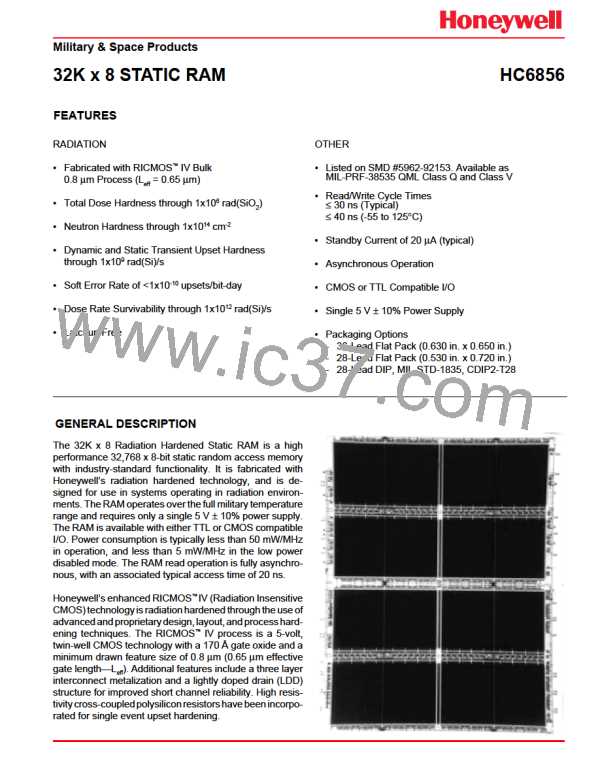HC6856
RADIATION CHARACTERISTICS
Total Ionizing Radiation Dose
The RAM will meet any functional or electrical specification
after exposure to a radiation pulse of ≤ 50 ns duration up to
1x1012 rad(Si)/s, when applied under recommended oper-
atingconditions.Notethatthecurrentconductedduringthe
pulse by the RAM inputs, outputs, and power supply may
significantly exceed the normal operating levels. The appli-
cation design must accommodate these effects.
The RAM will meet all stated functional and electrical speci-
fications over the entire operating temperature range after
the specified total ionizing radiation dose. All electrical and
timing performance parameters will remain within specifica-
tions after rebound at VDD = 5.5 V and T =125°C extrapo-
lated to ten years of operation. Total dose hardness is
assured by wafer level testing of process monitor transistors
and RAM product using 10 keV X-ray radiation. Transistor
gate threshold shift correlations have been made between
10 keV X-rays applied at a dose rate of 1x105 rad(SiO2)/min
at T = 25°C and gamma rays (Cobalt 60 source) to ensure
that wafer level X-ray testing is consistent with standard
military radiation test environments.
Neutron Radiation
The RAM will meet any functional or timing specification
after a total neutron fluence of up to 1x1014 cm-2 applied
under recommended operating or storage conditions. This
assumes an equivalent neutron energy of 1 MeV.
Transient Pulse Ionizing Radiation
Soft Error Rate
The RAM is capable of writing, reading, and retaining
storeddataduringandafterexposuretoatransientionizing
radiationpulseof≤1µsdurationupto1x109 rad(Si)/s,when
applied under recommended operating conditions. To en-
sure validity of all specified performance parameters be-
fore, during, and after radiation (timing degradation during
transient pulse radiation is ≤10%), it is suggested that a
minimum of 0.8 µF per part of stiffening capacitance be
placed between the package (chip) VDD and VSS, with a
maximum inductance between the package (chip) and
stiffening capacitance of 0.7 nH per part. If there are no
operate-through or valid stored data requirements, the
capacitance specification can be reduced to a minimum of
0.1 µF per part.
The RAM is capable of soft error rate (SER) performance
of <1x10-10 upsets/bit-day, under recommended operating
conditions. This hardness level is defined by the Adams
10% worst case cosmic ray environment.
Latchup
The RAM will not latch up due to any of the above radiation
exposure conditions when applied under recommended
operating conditions. Fabrication with the RICMOS™ p-epi
on p+ substrate process and use of proven design tech-
niques, such as double guardbanding, ensure latchup
immunity.
RADIATION HARDNESS RATINGS (1)
Limits (2)
Units
Test Conditions
Parameter
Total Dose
≥1x106
≥1x109
≥1x1012
rad(SiO2)
rad(Si)/s
rad(Si)/s
TA=25°C
Pulse width≤1 µs
Transient Dose Rate Upset (3)
Transient Dose Rate Survivability
Soft Error Rate: Level A
Level Z
Pulse width≤50 ns, X-ray,
VDD=6.6 V, TA=25°C
<1x10-9 (4)
Adams 10%
worst case environment
upsets/bit-day
<1x10-10
1 MeV equivalent energy,
Unbiased, TA=25°C
Neutron Fluence
≥1x1014
N/cm2
(1) Device will not latch up due to any of the specified radiation exposure conditions.
(2) Operating conditions (unless otherwise specified): VDD=4.5 V to 5.5 V, TA=-55°C to 125°C.
(3) Suggested stiffening capacitance specifications for optimum expected dose rate upset performance is stated above in the text.
(4) SER <1x10-10 u/b-d from -55 to 80°C.
3

 HONEYWELL [ Honeywell ]
HONEYWELL [ Honeywell ]